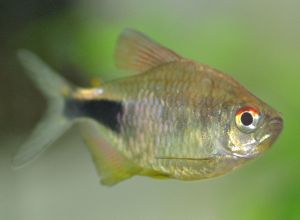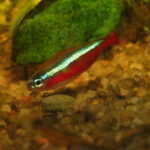The Emperor tetra is another beautiful species that is associated with the tropical aquarium hobby. This tetra known as nematobrycon palmeri, is a fairly common fish that may require some devotion looking for it as its popularity has escalated through the years due to its coloration, hardiness and compatibility with other fish species in a community environment. The Emperor Tetra represents one of the many tetra species that comes from South America.
The coloration of the emperor tetra can be best described as intense and gorgeous. A silvery gray color on the scales combined with a bright purple/blue thick lateral line makes this a beautiful fish. Their may also be some red and yellow in the tail region and a blue pupil of the eye. The size obtained with this fish is about three inches as an adult. The male is usually the larger of the two with the detection of the male from the female being more obvious in the shape of the tail. Males have a tri shaped tail (trident) with the lateral bluish purple line continuing all the way to the end of the middle caudal tail region, whereas the female has the normal characteristically “U” shaped style. Females also tend to be smaller in size and not as colorful and the iris of the eye is normally much bluer in males than their female counterpart.
Emperor tetras are becoming more and more a result of captive breeding as opposed to the collection of this fish in its natural wild state. This affords the price of this species to come down as well as the hardiness to improve. It is best to house this fish in schools, or schoals of four or more and with a slightly acid and soft water obtained with the addition of peat filtration. Water temperature around 80-82 is ideal for tetras as well as a host of other tropical fish. A tank filled with amazon sword and other species of live plants is ideal for their success. Subdued lighting is also very important to them as this helps to replicate their natural environment in the Colombian river basin area. Maintaining these fish in a community tank set up will also further enhance this fishes chances of long term success within a captive environment.
Feeding this fish is not anything elaborate that should be done by rocket scientists solely. Flake, freeze-dried, frozen or live foods can also be offered and will be readily accepted and devoured by Emperor Tetras. Brine shrimp, daphnia and mosquito larvae that are offered live will be a great addition especially with a breeding pair of Emperor’s. Feeding a variety of food in small amounts two to three times a day is the best way of ensuring that your fish are feeding properly and receiving the proper diet while not placing an added burden on your filtration or water quality.
Housing these tetras with a host of other species of tetra will offer you a great presentation of color, contrast, hardiness and enjoyment. Their peaceful disposition will allow you to add other different types of species of community fish to your population as well, without having to compromise selection and beauty often associated with housing fish in the cichlid family especially.
Remember to acclimate any fish slowly to assure that your tank water and water chemistry of the water in the bag and that of your tank are as closely simulated for the best results.







